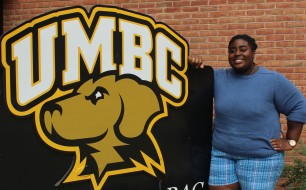A Call to Prayer: My Return to the Muslim Community
 A reflection written by Women’s Center staff member, MJ Jalloh Jamboria
A reflection written by Women’s Center staff member, MJ Jalloh Jamboria
The following is a little of my experience as a queer Muslim person. I recognize that my experience is not reflective of Islam, nor of the community of people I met at the Interfaith Center.
For the first time since last Eid al-Fitr, a Muslim holy holiday, I went to Jumu’ah (congregational Friday prayer). I met a person on campus who extended a warm hand and invited me to prayer which took place at the Interfaith Center. I was both excited and terrified for a plethora of reasons. I was excited to sit amongst my sisters, to rejoin the community I had left behind me as I entered college, and to listen to the guest Sheik that was invited to give the khutbah, the congregational sermon.
In the days leading up to the Friday prayer, all I could talk about was how excited I was that I finally had a friend to go to Jumu’ah with. I quickly realized, I had no idea how to be practicing Muslim anymore. I was once a Sunday school teacher and was really quite good at incorporating Islamic teachings into my life. However, since the start of college, I hadn’t really thought about being religious. I am not hijabi, a woman who wears hijab full-time. I’m not even a woman! I sometimes eat gelatin (oops!) and I don’t think I own a single piece of ‘modest’ clothing. I am a fat, queer, shorts and T-shirt wearing, ‘you kiss your mother with that mouth?’ swearing, mess of a person! Muslim people can be all of these things, but in prayer there are certain rules we must submit to. The expectation for women is to stand in a section separate from men, covered in appropriate prayer attire and hair and neck wrapped in a veil. The thought of completing some of these actions made me nervous.
Friday came and I finally decided upon an outfit that was appropriate, picked a hijab and walked over to the Interfaith Center. The prayer went well, I loved the khutbah (the sermon given by the person who leads prayer, usually the Sheik) and I felt like was I finally home. Even though I had only spent an afternoon with these sisters, I knew I found a community of women who understood and loved me. In fact, the khutbah before the prayer was almost serendipitous. The Sheik recited a line about friendship. He reminded the congregation that we should all find friends that we love purely for God’s sake. With the women that surrounded me, I felt I finally found the very friends the Sheik was talking about.
Despite all of the affirmation I felt in the space, I was (and am) still challenged by the fact that a large part of my identity has to be put on hold to enter into this space of prayer. Since high school, simple and arbitrary gender markers have been instrumental in the way that I’ve been able to present my identity. My name, the way I dress and talk, even the way I wear my hair have become the only way I can really be non-normative and express who I am. As I got ready for prayer that morning, I felt like I was hiding and changing who I am. I had to find clothes that weren’t form-fitting and that covered my body. I put on a hijab and while I love what hijab represents, it too plays a role in covering up important parts of my identity. I’ve been growing my locs for the past 2 years and they’ve become a prized familial tradition I don’t want to hide. But, both the hijab and the clothes were material. Whenever I was asked my name, I cringed as I introduced myself as Sister Mariam as opposed to “MJ.” I love my birthname. I love the woman I am named after and I love the religious significance of my name. But, I hate lying. I am no longer Mariam. I am not the pious Sunday school teacher anymore. I’m MJ, a queer, potty-mouth, music-loving, dances in their underwear kind of person who also happens to be Muslim.
While it would be easier to just not stress over being called by my birthname and changing my appearance, I think I owe it to myself to look for a space where all of my identities are acknowledged and valued and allowed to intersect. I’ve previously felt like I had to filter parts of myself to fit into certain spaces. In queer and feminist spaces, I’ve felt a disconnect from my religion. While in Muslim settings I’m forced back into the closet. It’s important to find communities and spaces where all of our identities and embodiments are acknowledged, valued, and perhaps even loved!
I have yet to return to the Interfaith Center. Two weeks have gone by, and instead of joining the congregation, I steal glances as I pass the Center on my way to The Commons. I haven’t decided whether or not I’ll be going to another Friday prayer just yet. I want to be among my sisters again, but not at the cost of other parts of my identity that I’ve worked so hard to be able to express.
For more on practicing and incorporating intersectionality into our lives and feminism, check out Why Our Feminism Must Be Intersectional (And 3 Ways to Practice It) from Everyday Feminism.
And, to read another person’s experience related to intersectional feminism and her Muslim identity, read Maha Saleem’s reflection on AAUW’s blog.
Posted: May 10, 2016, 12:20 PM